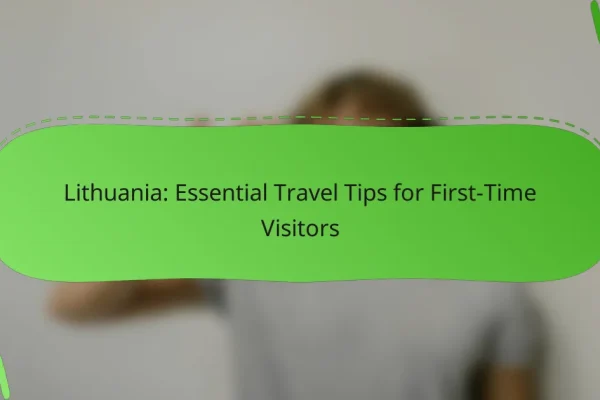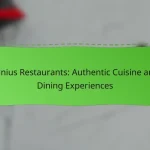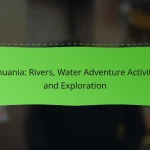What are the best travel tips for visiting Lithuania?
The best travel tips for visiting Lithuania include exploring its rich cultural heritage, savoring traditional dishes, and navigating efficiently through its cities. Understanding local customs and planning around festivals can enhance your experience significantly.
Explore Vilnius’ UNESCO World Heritage sites
Vilnius, the capital of Lithuania, is home to several UNESCO World Heritage sites that showcase its unique architecture and history. Notable sites include the Historic Centre of Vilnius, with its stunning Baroque buildings and the iconic Gediminas Tower.
When visiting, consider taking a guided tour to gain deeper insights into the city’s past. Allocate a full day to explore these sites to fully appreciate their significance and beauty.
Try traditional Lithuanian cuisine
Sampling traditional Lithuanian cuisine is a must for any visitor. Dishes like cepelinai (potato dumplings filled with meat) and šaltibarščiai (cold beet soup) offer a taste of local flavors. Many restaurants in Vilnius serve these dishes, often at reasonable prices.
Don’t miss trying local pastries such as kibinai and various rye breads. Pair your meal with a glass of local beer or kvass for a complete experience.
Utilize public transport for easy navigation
Public transport in Lithuania, particularly in Vilnius, is efficient and affordable. Buses and trolleybuses cover most areas, making it easy to navigate the city. A single ticket costs around €1 and is valid for a limited time across multiple modes of transport.
Consider purchasing a day pass if you plan to travel frequently within the city. This can save you money and time, allowing you to focus on enjoying your trip.
Learn basic Lithuanian phrases
Learning a few basic Lithuanian phrases can enhance your interactions with locals. Simple greetings like “Labas” (Hello) and “Ačiū” (Thank you) go a long way in showing respect for the culture.
While many Lithuanians speak English, especially in urban areas, making an effort to speak the local language can lead to more meaningful connections and experiences.
Plan visits around local festivals
Local festivals in Lithuania provide a vibrant glimpse into the culture and traditions of the country. Events such as the Vilnius Festival and the Užgavėnės (pre-Lenten festival) offer unique experiences filled with music, dance, and traditional foods.
Check local calendars before your trip to align your visit with these celebrations, as they can significantly enrich your travel experience and provide opportunities to engage with locals in a festive atmosphere.
What are the must-see attractions in Lithuania?
Lithuania boasts a rich tapestry of cultural and natural attractions. Key sites include the historic Vilnius Old Town, the picturesque Trakai Castle, the engaging Klaipėda Sea Museum, and the stunning Curonian Spit National Park.
Vilnius Old Town
Vilnius Old Town is a UNESCO World Heritage site known for its well-preserved medieval architecture and vibrant atmosphere. Visitors can explore cobblestone streets lined with baroque churches, charming cafes, and unique shops.
Key highlights include the stunning Cathedral Square, the Gediminas Tower, and the artistic Užupis district, which has declared itself an independent republic. Plan to spend a full day wandering to fully appreciate its beauty and history.
Trakai Castle
Trakai Castle, located on an island in Lake Galvė, is one of Lithuania’s most iconic landmarks. This 14th-century fortress offers a glimpse into the country’s medieval past and is surrounded by picturesque scenery.
Visitors can take a guided tour of the castle, which includes exhibits on Lithuanian history and culture. The area also provides opportunities for boating and hiking, making it a great spot for a day trip from Vilnius.
Klaipėda Sea Museum
The Klaipėda Sea Museum is dedicated to maritime history and the natural environment of the Baltic Sea. Housed in a former fort, the museum features exhibits on marine life, shipbuilding, and the region’s fishing traditions.
Don’t miss the adjacent dolphin and sea lion shows, which are popular with families. The museum is a great way to learn about Lithuania’s coastal heritage while enjoying a day by the sea.
Curonian Spit National Park
Curonian Spit National Park is a unique UNESCO World Heritage site that features stunning sand dunes, forests, and diverse wildlife. This narrow strip of land separates the Curonian Lagoon from the Baltic Sea and is ideal for nature lovers.
Visitors can hike or bike along designated trails, explore charming fishing villages, and enjoy pristine beaches. Be sure to check local regulations regarding camping and conservation to help preserve this beautiful area.
How to navigate Lithuania’s public transport?
Navigating Lithuania’s public transport is straightforward, especially in major cities like Vilnius and Kaunas. Public transport includes buses, trams, and trolleybuses, which are efficient and affordable options for getting around.
Use Vilnius public transport app
The Vilnius public transport app is a convenient tool for travelers. It provides real-time information on schedules, routes, and ticket purchasing options, making it easier to plan your journey.
Download the app from the App Store or Google Play, and you can access features like route planning and notifications about delays. This app is particularly useful for first-time visitors who may not be familiar with the transport system.
Purchase multi-day travel cards
Multi-day travel cards offer a cost-effective way to use public transport in Lithuania. These cards can be purchased for various durations, typically ranging from one to seven days, allowing unlimited travel within that period.
Prices for these cards are generally affordable, often around 10-20 EUR depending on the duration. This option is ideal for tourists planning to explore multiple attractions without worrying about individual ticket costs.
Understand bus and tram routes
Understanding the bus and tram routes is essential for efficient travel in Lithuania. Each route is numbered, and stops are clearly marked, making it easy to identify where to board and alight.
Familiarize yourself with the main routes in Vilnius, such as the 1, 3, and 5 buses, which connect key areas. Maps are available at stops and online, helping you navigate the system with confidence.
What are the best times to visit Lithuania?
The best times to visit Lithuania are during the summer, winter, and spring, each offering unique experiences. Summer is ideal for festivals and outdoor activities, winter showcases enchanting Christmas markets, and spring brings vibrant blooming nature.
Summer for festivals and outdoor activities
Summer in Lithuania, particularly from June to August, is vibrant with numerous festivals and outdoor activities. Cities like Vilnius and Kaunas host music festivals, cultural events, and food fairs that attract both locals and tourists.
Outdoor enthusiasts can enjoy hiking, cycling, and water sports in the picturesque national parks and along the Baltic Sea coast. The long daylight hours provide ample time to explore, so consider planning your itinerary around major events for a lively experience.
Winter for Christmas markets
Winter, especially from late November to early January, transforms Lithuania into a festive wonderland with charming Christmas markets. Vilnius’ Cathedral Square is famous for its market, where visitors can find handcrafted gifts, local delicacies, and mulled wine.
The atmosphere is magical, with twinkling lights and traditional music enhancing the experience. Be sure to try local treats like gingerbread and smoked meats while enjoying the seasonal festivities.
Spring for blooming nature
Spring, from March to May, is a beautiful time to visit Lithuania as nature comes to life. Parks and gardens burst into bloom, making it perfect for leisurely walks and photography. The weather is mild, allowing for comfortable exploration of both urban and rural areas.
Spring is also an excellent time for birdwatching, particularly in the wetlands and nature reserves. Consider visiting the Curonian Spit, where you can witness the stunning landscapes and diverse wildlife as they awaken from winter.
What are the cultural etiquette tips for Lithuania?
Understanding cultural etiquette in Lithuania is essential for respectful interactions. Key practices include respecting local customs, dressing appropriately in religious sites, and greeting locals politely.
Respect local customs and traditions
Lithuania has a rich cultural heritage, and respecting local customs is vital. Be aware of traditional celebrations, such as Užgavėnės, which marks the end of winter, and participate if invited. Avoid discussing sensitive historical topics unless locals bring them up.
When visiting rural areas, observe local practices, such as hospitality norms. It’s common to be offered food or drink, and declining may be seen as impolite. Accepting with gratitude fosters goodwill.
Dress modestly when visiting churches
When visiting churches in Lithuania, modest attire is expected. Women should wear skirts or dresses that cover the knees, while men should avoid shorts. It’s advisable to cover shoulders as well.
In some churches, head coverings for women may be required. Always check the specific dress code of the church you plan to visit to ensure compliance with local customs.
Be polite and greet locals
Politeness is highly valued in Lithuanian culture. A simple “Labas” (Hello) when meeting someone can go a long way. Use formal titles and surnames unless invited to use first names.
When entering shops or restaurants, greet staff with a smile and a friendly “Labas.” This small gesture shows respect and can enhance your experience while interacting with locals.
What are the local dishes to try in Lithuania?
Lithuania offers a rich culinary experience with traditional dishes that reflect its agricultural heritage. Key local dishes include cepelinai, šaltibarščiai, and kibinai, each showcasing unique flavors and ingredients.
Cepelinai
Cepelinai, or zeppelins, are large potato dumplings typically filled with minced meat, curd, or mushrooms. They are named for their shape, resembling airships, and are often served with a creamy sauce or sour cream. This dish is a staple in Lithuanian cuisine and is best enjoyed during colder months.
When trying cepelinai, consider ordering them at local restaurants where they are made fresh. Prices usually range from 5 to 10 EUR, depending on the portion size and location.
Šaltibarščiai
Šaltibarščiai is a vibrant cold beet soup, perfect for summer. Made with beets, cucumbers, dill, and buttermilk, it is served chilled and often garnished with boiled eggs. This refreshing dish is not only visually appealing but also nutritious.
Look for šaltibarščiai in traditional eateries or local markets. It typically costs around 3 to 6 EUR and pairs well with rye bread.
Kibinai
Kibinai are savory pastries filled with meat, vegetables, or cheese, originating from the Karaim community in Lithuania. These hand-held delights are baked until golden and are perfect for a quick snack or meal. They are often enjoyed with a side of sour cream or a fresh salad.
When sampling kibinai, check out local bakeries or street food vendors. Prices usually range from 2 to 5 EUR each, making them an affordable option for travelers.






